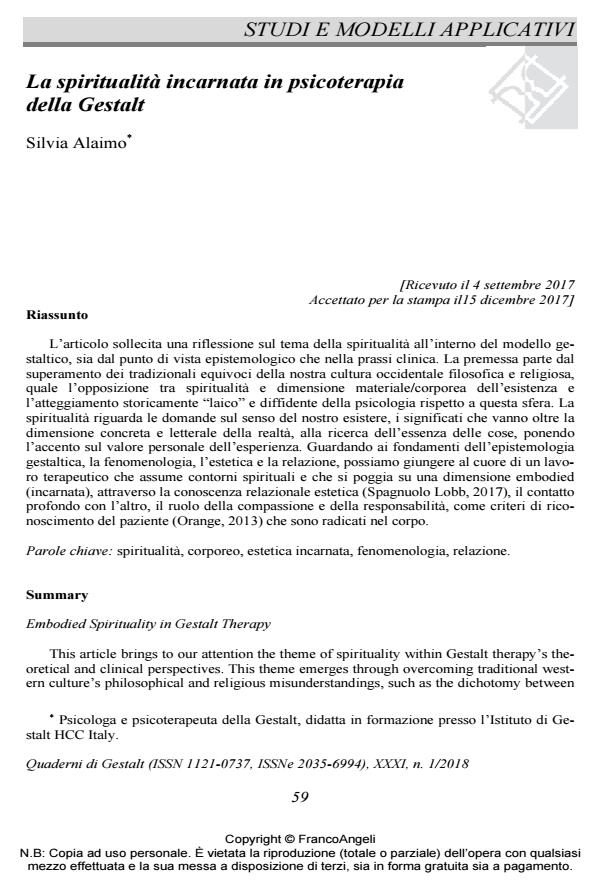La spiritualità incarnata in psicoterapia della Gestalt
Titolo Rivista QUADERNI DI GESTALT
Autori/Curatori Silvia Alaimo
Anno di pubblicazione 2018 Fascicolo 2018/1
Lingua Italiano Numero pagine 12 P. 59-70 Dimensione file 205 KB
DOI 10.3280/GEST2018-001005
Il DOI è il codice a barre della proprietà intellettuale: per saperne di più
clicca qui
Qui sotto puoi vedere in anteprima la prima pagina di questo articolo.
Se questo articolo ti interessa, lo puoi acquistare (e scaricare in formato pdf) seguendo le facili indicazioni per acquistare il download credit. Acquista Download Credits per scaricare questo Articolo in formato PDF

FrancoAngeli è membro della Publishers International Linking Association, Inc (PILA)associazione indipendente e non profit per facilitare (attraverso i servizi tecnologici implementati da CrossRef.org) l’accesso degli studiosi ai contenuti digitali nelle pubblicazioni professionali e scientifiche
L’articolo sollecita una riflessione sul tema della spiritualità all’interno del modello gestaltico, sia dal punto di vista epistemologico che nella prassi clinica. La premessa parte dal superamento dei tradizionali equivoci della nostra cultura occidentale filosofica e religiosa, quale l’opposizione tra spiritualità e dimensione materiale/corporea dell’esistenza e l’atteggia¬mento storicamente "laico" e diffidente della psicologia rispetto a questa sfera. La spiritualità riguarda le domande sul senso del nostro esistere, i significati che vanno oltre la dimensione concreta e letterale della realtà, alla ricerca dell’essenza delle cose, ponendo l’accento sul valore personale dell’esperienza. Guardando ai fondamenti dell’epistemologia gestaltica, la fenomenologia, l’estetica e la relazione, possiamo giungere al cuore di un lavoro terapeutico che assume contorni spirituali e che si poggia su una dimensione embodied (incarnata), attraverso la conoscenza relazionale estetica (Spagnuolo Lobb, 2017), il contatto profondo con l’altro, il ruolo della compassione e della responsabilità, come criteri di riconoscimento del paziente (Orange, 2013) che sono radicati nel corpo.
Parole chiave:Spiritualità, corporeo, estetica incarnata, fenomenologia, relazione.
- Borino T. (2013). Il Training Autogeno in psicoterapia della Gestalt. Rilassamento, consapevolezza, vitalità. Quaderni di Gestalt, XXVI, 1: 109-123. DOI: 10.3280/GEST2013-001009
- Clement O., Serr J. (2015). La preghiera del cuore. Milano: Ancora (ed. or.: La prière du coeur, Abbaye De Bellefontaine, 2011).
- Damasio A. (2000). Emozione e Coscienza. Milano: Adelphi.
- Gallese V. (2008). Il corpo teatrale: mimetismo, neuroni specchio, simulazione incarnata. Culture teatrali, 16: 13-38.
- Gelin A. (1968). L’uomo secondo la Bibbia. Edizioni Ligel, testo disponibile sul sito: www.ora-et-labora.net.
- Erbuto D. (2014). Riflessioni sull’esperienza della corporeità: tra Leib e Körper. CorpoNarrante. Rivista online dell’IIFAB, Istituto Italiano di Formazione in Analisi Bioenergetica, 7. -- Testo disponibile sul sito: www.corponarrante.it.
- Irigaray L. (2011). Tra Oriente e Occidente. Dalla singolarità alla comunità. Roma: Manifestolibri (ed. or.: Entre Orient et Occident. Paris: Grasset, 1999).
- Mancuso V. (2010). Il corpo nella religione. Intervento nell’ambito della manifestazione dal titolo “Il corpo nella religione, sentire il Vuoto, sentire il Divino” (Modena 17/12/2010), trasposizione da audio registrazione non rivista dall’autore, -- http://www.vitomancuso.it/wp-content/uploads/2011/10/Il-corpo-nella-religione.pdf.
- Nelson J.M. (2009). Psychology, Religion, and Spirituality. New York, NY: Springer Science.
- Orange D. (2013). Dal riconoscimento alla responsabilità: la costituzione della soggettività. Conferenza Internazionale ISIPSE, Roma.
- Perls F.S., Hefferline R.F., Goodman P. (1997). Teoria e pratica della terapia della Gestalt: Vitalità e accrescimento nella personalità umana. Roma: Astrolabio (ed. or.: Gestalt Therapy: Excitement and Growth in the Human Personality. New York, NY: The Gestalt Journal Press, 1951; 1995).
- Roof, W. C. (1999). Spiritual Marketplace: Baby Boomers and the Remaking of American Religion. Princeton, NJ: Princeton University Press.
- Spagnuolo Lobb M. (2011). Il now-for-next in psicoterapia. La psicoterapia della Gestalt raccontata nella società post-moderna. Milano: FrancoAngeli.
- Spagnuolo Lobb M. (2013). Il corpo come “veicolo” del nostro essere nel mondo. L’esperienza corporea in psicoterapia della Gestalt. Quaderni di Gestalt, XXVI, 1: 41-65. DOI: 10.3280/GEST2013-001004
- Spagnuolo Lobb M. (2017). La conoscenza relazionale estetica del campo. Per uno sviluppo del concetto di consapevolezza in psicoterapia della Gestalt e nella clinica contemporanea. Quaderni di Gestalt, XXX, 1: 17-33. DOI: 10.3280/GEST2017-001003
- Staemmler F.M. (2007). On Macaque Monkeys, Players, and Clairvoyants: Some New Ideas for a Gestalt Therapeutic Concept of Empathy. Studies in Gestalt Therapy, 1 2: 43-639.
- Venturini R. (2010). Ri-legature buddhiste. Roma: Edizioni Universitarie Romane.
- Zinnbauer B.J., Pargament K.I., Scott A.B. (1999). The Emerging Meanings of Religiousness and Spirituality: Problems and Prospects. Journal of Personality, 67: 889-919.
- L'es in psicoterapia della Gestalt Mercurio Albino Macaluso, in QUADERNI DI GESTALT 1/2022 pp.47
DOI: 10.3280/GEST2022-001004 - Vitalità: psicoterapia, antropologia e spiritualità a confronto Stefano Boni, Stefania Consigliere, Salvatore Greco, Henry Herrera, Giulia Nora Pappalardo, Luca Pino, in QUADERNI DI GESTALT 2/2024 pp.11
DOI: 10.3280/GEST2023-002002
Silvia Alaimo, La spiritualità incarnata in psicoterapia della Gestalt in "QUADERNI DI GESTALT" 1/2018, pp 59-70, DOI: 10.3280/GEST2018-001005